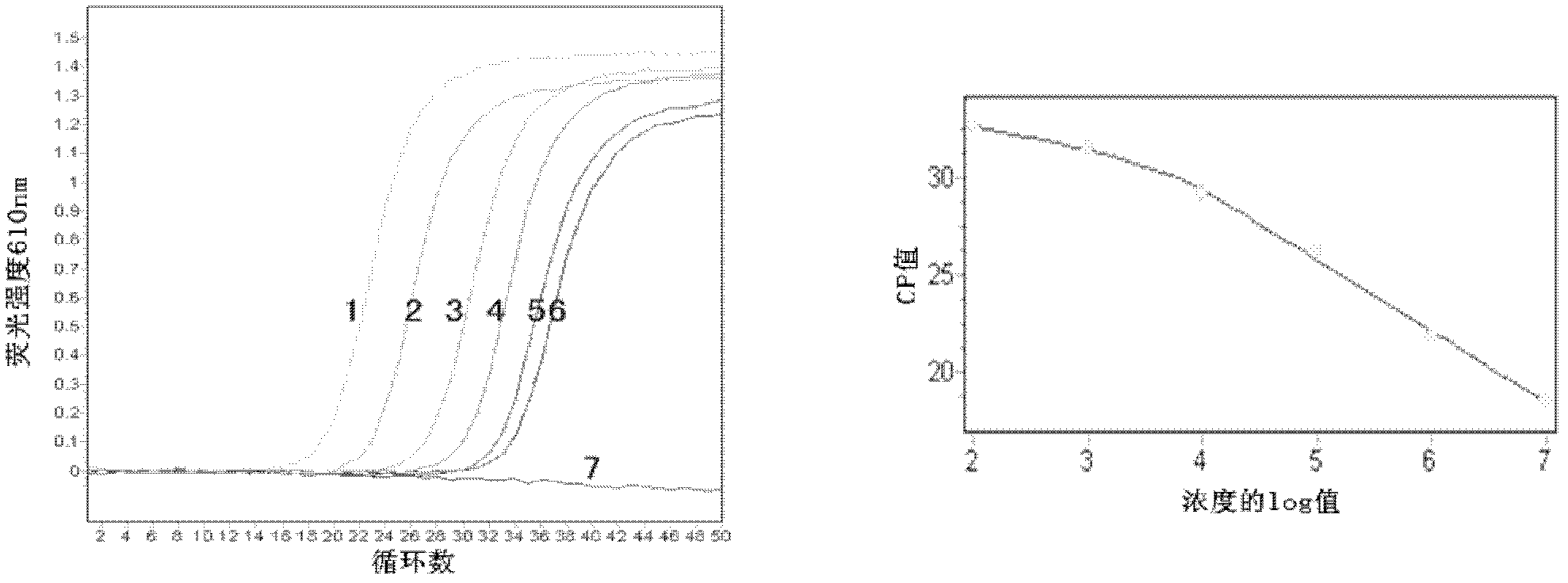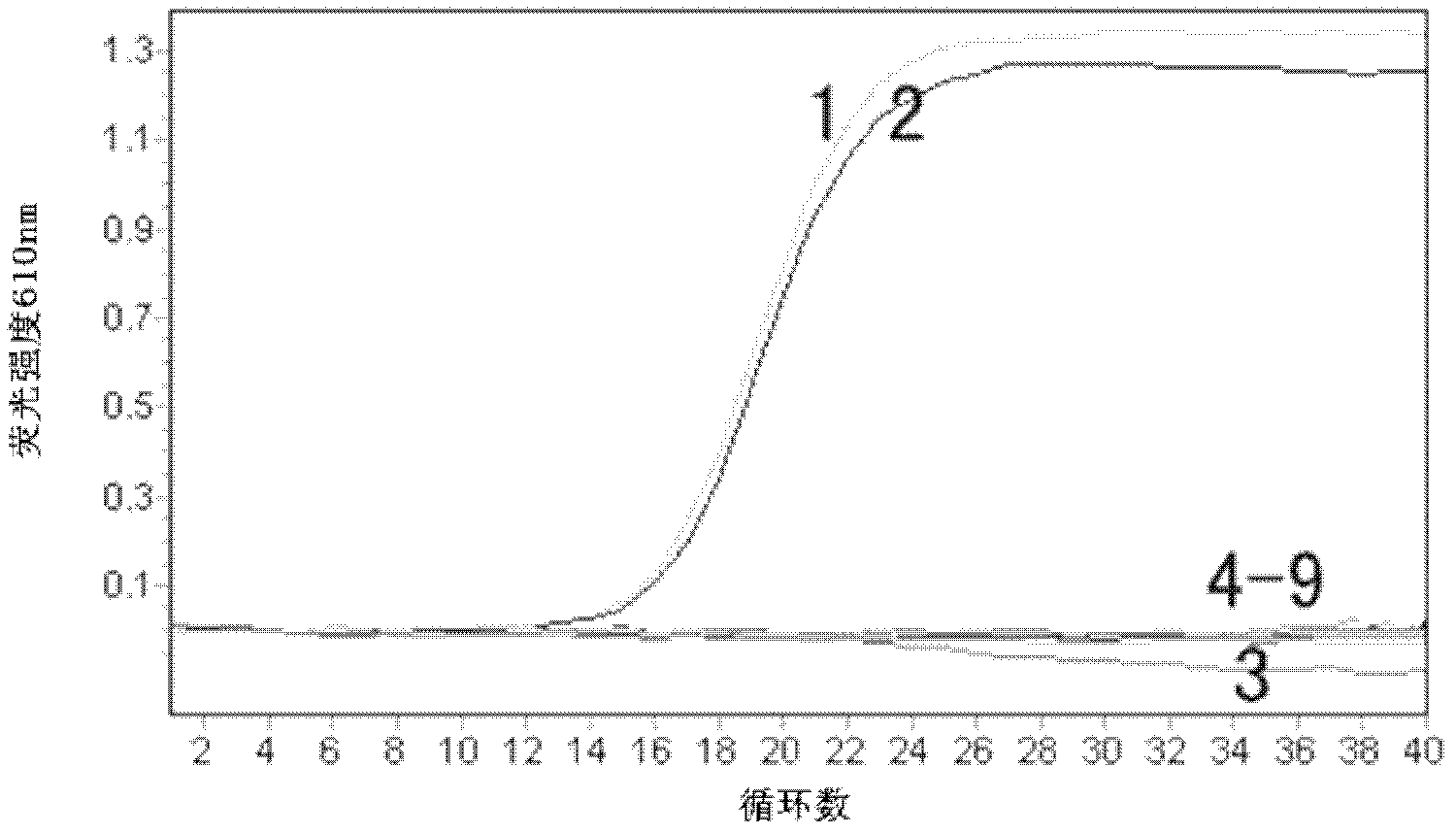Double fluorescence quantitative reverse transcription-polymerase chain reaction (RT-PCR) detection kit for duck hepatitis virus I and Muscovy duck parvovirus
A technology of Muscovy duck parvovirus and hepatitis virus, which is applied in the biological field and can solve the problems of high requirements and complexity of reagents and primers
- Summary
- Abstract
- Description
- Claims
- Application Information
AI Technical Summary
Problems solved by technology
Method used
Image
Examples
Embodiment 1
[0044] Embodiment 1, design and synthesis of primers and Taqman probes
[0045] According to the conserved sequences of duck hepatitis I virus and Muscovy duck parvovirus in GenBank, two pairs of specific primers and two Taqmam probes were designed using Primer Express3.0 software (Table 1).
[0046] Table 1 is the primer and TaqMan probe sequence (5'-3')
[0047]
Embodiment 2
[0048] Embodiment 2, fluorescence quantitative RT-PCR detection
[0049] 1. Determination of fluorescent quantitative RT-PCR detection method
[0050] 1. Sample preparation
[0051]1), nucleic acid extraction
[0052] Refer to the instructions of the TIANamp virus genome DNA / RNA extraction kit to extract the RNA of duck type I hepatitis virus AV2111 (DHV I), Newcastle disease virus and H9 subtype avian influenza, and extract Muscovy duck parvovirus, duck circovirus and goose plague Virus and DNA of duck plague virus AV1221 strain.
[0053] 2), reverse transcription of RNA
[0054] Duck Type I Hepatitis Virus AV2111 RNA was reverse-transcribed to synthesize cDNA, specifically as follows: the following reverse transcription system was established, the total reaction volume was 20 μL, the duck Type I Hepatitis Virus AV2111 RNA in the above 1) was 2 μL (about 20 μg), 4 μL 8mM MgCl 2 (Dalian Bioengineering Co., Ltd., catalog number: DRR0019A), 2 μL 10×PCR buffer (Dalianbao Bioe...
Embodiment 3
[0094] Embodiment 3, the detection of clinical disease material
[0095] The samples to be tested were 118 diseased materials (numbered 1-118) collected from duck populations in Guangxi, and the RNA and DNA of duck diseased materials (liver of sick duck, spleen of sick duck or lung of sick duck) were extracted respectively.
[0096] The DNA and RNA of each sample numbered 1-118 were mixed (volume ratio 1:1) as a template, and fluorescent quantitative RT-PCR was carried out according to 1-3 of Example 2.
[0097] If the reaction result under the 610nm excitation light (ROX) is an S-shaped curve, the sample to be tested contains duck hepatitis I virus; otherwise, the sample does not contain duck hepatitis I virus;
[0098] If the reaction result under the 530nm excitation light (FAM) is an S-shaped curve, the sample to be tested contains Muscovy duck parvovirus; otherwise, the sample does not contain Muscovy duck parvovirus;
[0099] If the reaction results under the 610nm exci...
PUM
 Login to View More
Login to View More Abstract
Description
Claims
Application Information
 Login to View More
Login to View More - R&D
- Intellectual Property
- Life Sciences
- Materials
- Tech Scout
- Unparalleled Data Quality
- Higher Quality Content
- 60% Fewer Hallucinations
Browse by: Latest US Patents, China's latest patents, Technical Efficacy Thesaurus, Application Domain, Technology Topic, Popular Technical Reports.
© 2025 PatSnap. All rights reserved.Legal|Privacy policy|Modern Slavery Act Transparency Statement|Sitemap|About US| Contact US: help@patsnap.com



